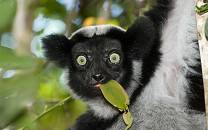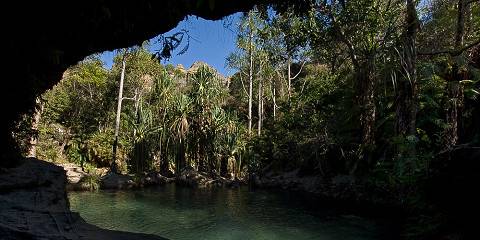While many visitors to Madagascar come for the beautiful beaches, the island is a top ecotourism destination thanks to its 50 national parks and reserves. If you like an active holiday, Madagascar won’t disappoint as most wildlife viewing is done on foot. For a true adventure, you can even go out at night, looking for animals by flashlight.

-
Rates (USD)
- $158 to $437 pp/day
-
Best Time To Go
- April, May, October and November (Less rain, good wildlife viewing; varies by region)
-
High Season
- July, August and December holidays (Popular parks get crowded)
-
Size
- 587,041km² / 226,658mi²


Pros & Cons
- Idyllic beaches and island culture
- Unique habitats and wildlife
- Incredible array of spectacular landscapes
- Great hiking opportunities
- Relatively off-the-beaten-track eco-destination
- Roads in generally poor condition
- Rain is possible throughout the year
Wildlife
Madagascar is a diversity hot spot, offering a unique kind of safari. You won’t see the ‘normal’ safari animals here – there are no elephants or lions. Instead, the island is home to more than 100 species of lemurs, from the large indri to tiny dwarf lemurs, as well as an abundance of reptiles, amphibians and birds. Most of these are found only in Madagascar. Of particular interest are the chameleons.
More about the wildlife
Things To Do
Madagascar offers an alluring combination of seaside and wildlife-oriented activities. The beaches are great for swimming and many also offer diving, snorkeling and other boat excursions. Guided wildlife viewing is usually on foot (options range from easy walks to demanding overnight hikes) and you’re likely to spot lemurs, chameleons and endemic birds in most protected areas. Night walks, to look for wildlife, are offered outside some national parks.
Weather & Climate
Madagascar has a hot tropical climate, but there are big regional variations. In the highlands of the interior, you’ll experience a cooler and less humid climate. There is a lot of rain throughout the year on the east coast, but the south of the island is usually hot and dry. There are, however, Wet (November to April) and Dry (May to October) seasons throughout the country, although the Dry season can start in April or May, depending on the area.
More about the weather and climate
Best Time To Visit
The shoulder months of April, May, October and November are the ideal travel times in most areas, although there are some regional variations between parks. The cool, dry months from June to August or September are very pleasant, but these months are less rewarding for wildlife viewing because many animals (including lemurs) are less active during cooler weather. January to March is the height of the Wet season. This is also referred to as cyclone season, and the east coast is particularly at risk at this time. July, August and the December holidays are best avoided due to crowds.
More about the best time to visit
Premier Parks & Reserves
- Andasibe-Mantadia NP – Rainforest hikes, lemur spotting
- Bemaraha NP – Scenic hikes with
- Isalo NP – Scenic hikes
- Ankarana SR – Scenic hikes with tsingy
- Masoala NP – Scenic rainforest hikes
- Ranomafana NP – Rainforest hikes, lemur spotting
- All 20 Madagascar Parks & Reserves




